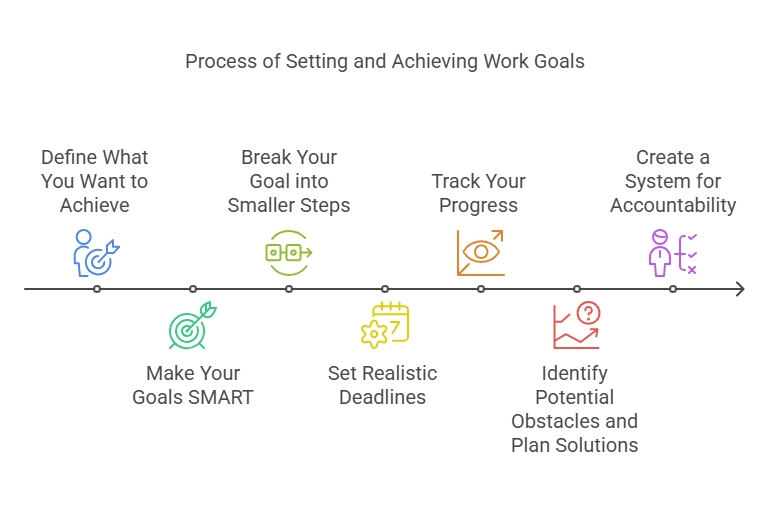Setting goals at work can feel overwhelming, but trust me, once you get the hang of it, it becomes easy to do. Whether you want to improve your work performance, get a promotion, or simply stay on top of your tasks, writing clear, achievable goals is the key. In this guide, I’ll show you how to write goals for work efficiently – no corporate jargon, just practical, real-life advice. Plus, I’ve got some free goal-setting printables to help you stay on track!
Why Do We Set Goals at Work?
Before diving into the “how,” let’s talk about the “why.” Setting goals at work gives us direction, motivation, and a sense of accomplishment. Without goals, it’s easy to feel stuck, like you’re just going through the motions without making real progress. Whether you’re working towards personal growth or contributing to a bigger company vision, having clear goals helps you stay focused and motivated.
- Goals give you direction (so you’re not just reacting to whatever comes up).
- They help you stay motivated, especially when work gets tough.
- Achieving them builds confidence and momentum.
- They make performance reviews way easier (because you have a clear record of progress).

If you’ve ever felt stuck or like you’re just going through the motions, setting the right goals can help you take control of your work life.
Step 1: Define What You Want to Achieve
The first step in writing work goals is knowing what you actually want. Are you trying to develop a new skill? Get better at time management? Increase your productivity? Having a clear vision makes setting goals so much easier. Think about:
- How do you want to feel about your work?
- Where do you want to be in a year? Five years?
- What skills do you want to develop?
Example: If you want to become better at project management, your goal could be: “Improve my ability to manage multiple projects efficiently by learning and implementing a new task management system.”
Looking to get more organized? Check out my weekly planning templates to help you manage your time better!
Step 2: Make Your Goals SMART
You’ve probably heard of SMART goals before, and there’s a good reason for that – they work! If you’re wondering how to write SMART goals for work, here’s a quick breakdown:
- Specific – Clearly define what you want to achieve
- Measurable – Make sure you can track your progress
- Achievable – Keep it realistic
- Relevant – Align it with your personal and professional growth
- Time-bound – Set a deadline
Example: Instead of saying, “I want to be better at public speaking,” try: “I will complete a public speaking course and give three presentations at team meetings within the next six months.”
Step 3: Break Your Goal into Smaller Steps
Big goals can be intimidating, so breaking them down into smaller steps makes them easier to tackle. Think of your goal as a staircase – each small step gets you closer to the top.
Example: If your goal is to “learn advanced Excel skills,” your smaller steps might look like this:
- Watch an Excel tutorial every week.
- Practice using new functions in real projects.
- Take an online course and earn a certification.
- Apply new Excel skills in work reports.
Looking for ways to stay accountable? My goal trackers can help you stick to your goals, and I actually made one tracker with stairs as the visual representation!
Step 4: Set Realistic Deadlines
If you’re wondering how to set realistic goals at work, one key factor is the timeline. Giving yourself too little time can lead to frustration, while too much time can cause procrastination. Find a balance that challenges you but is still achievable.
Example: If your goal is to improve your leadership skills, setting a deadline like “Attend a leadership workshop within the next three months” keeps you on track.
Step 5: Track Your Progress
Writing work goals is just the beginning – you need to track them too! Regular check-ins help you see how far you’ve come and what adjustments you need to make. You can use a planner, an app, or a simple checklist.
Example: If your goal is to “read one professional development book per month,” you can track your progress by listing the books you’ve read and setting reminders.
Step 6: Identify Potential Obstacles and Plan Solutions
Every goal comes with challenges. Identifying potential obstacles in advance can help you stay on track when setbacks arise. Think about what might get in the way of your progress and create a plan to overcome those hurdles.
Example: If your goal is to complete an online certification, potential obstacles might include a busy schedule or difficulty understanding certain topics. Solutions could include setting aside dedicated study time and seeking help from colleagues or online communities.
Step 7: Create a System for Accountability
Staying accountable can make a huge difference in whether or not you achieve your goals. Find a system that works for you, whether it’s a coworker who checks in on your progress, a journal where you document milestones or an app that sends reminders.
Example: If your goal is to improve your writing skills, you could join a writing group where members provide feedback and encouragement, or set weekly deadlines for completing writing exercises.
How Do Goals and a Vision Work Together?
Goals are the steps that lead to your bigger vision. If your vision is to become a team leader, your goals might include improving your communication skills, taking on more responsibilities, and attending leadership workshops. Each small goal brings you closer to that vision.
Final Thoughts: How to Write Goals for Work That Work
Writing goals for work doesn’t have to be complicated. By following these steps – defining what you want, making SMART goals, breaking them down, setting deadlines, tracking progress, identifying obstacles, and staying accountable – you can set yourself up for success. Whether you’re aiming for personal growth or career advancement, clear and structured goals will help you get there.
At the end of each quarter or project, ask yourself:
- Did I reach my goal? Why or why not?
- What worked well?
- What should I change next time?
FAQ
Setting and achieving goals can come with a lot of questions. Here are some common ones to help you navigate the process more effectively.
Good development goals depend on your career and interests but can include improving communication skills, learning a new software program, developing leadership abilities, or increasing productivity.
Start small and focus on one or two key areas. Break your goals into manageable steps and use a planner to stay on track.
Follow the SMART method: Specific, Measurable, Achievable, Relevant, and Time-bound. A good example would be: “Complete an online marketing certification by June to improve my digital skills.”
Consider your workload, available resources, and time constraints. Setting overly ambitious goals can lead to burnout, so find a balance that challenges you without overwhelming you.
